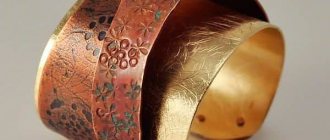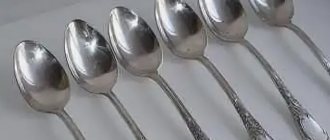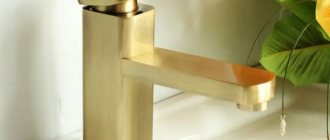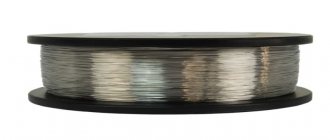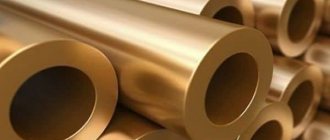Copper forms the basis of a number of alloys with similar visual properties and mechanical characteristics, making them difficult to identify at home. The question most often arises is: how to distinguish bronze from brass? In laboratory conditions, using special equipment - an optical, x-ray or laser analyzer - it is not difficult to determine the composition of the material. In everyday life, for this purpose you will have to use other methods, the results of which should be treated quite critically - none guarantee 100% accuracy.
Properties of bronze
It is well known that brass is produced by alloying copper with zinc, but the inclusion of Zn in the alloy differs significantly - from 4% to 45%. Thanks to this, alloys of different grades, for example L96 and L59-1, visually and qualitatively have special properties.
Bronze is even more difficult to recognize. What is the difference between brass and bronze: to create the latter, copper is combined with tin, and also alloyed with aluminum, beryllium, silicon, manganese, magnesium or non-metallic elements. As a result, the chemical composition of existing alloys is so diverse that it is difficult to identify not only the grades, but also to identify them with each other.
If you use their representatives of premium brands to compare the characteristics of the two alloys, then bronze differs from brass:
- weight - it is higher due to the presence of tin, which is heavier than zinc;
- better corrosion resistance. The consequences of contact with salt-containing water for bronze products are minimal, and to increase the anti-corrosion properties of brass parts, the material is alloyed;
- high wear resistance due to lower friction coefficient.
It follows from this that bronze alloys are stronger than brass, but for solving the problem of how to identify bronze or brass at home, this has no practical value.
Comparison criteria
Despite the fact that in metallurgy there are clear criteria for distinguishing these two alloys, in real life an uninformed person is unlikely to accurately identify them.
Compound
Clear differences between metals can be traced only if the alloys do not contain impurities. However, now there are a large number of their varieties, which makes identification difficult. Brass is designated by the letter “L”; subsequent symbols in the marking indicate the presence of the main elements and the average copper content as a percentage. For example, L70 means 70% Cu content, and LAZ60-1-1 consists of 60% copper, 1% aluminum and 1% iron.
In a brass alloy, copper is combined with zinc, which gives the metal ductility and a low degree of wear resistance. This is the main additional element, but brass can be two-component or multi-component. There are different types of it.
- Deformable alloys. They are used in the production of machine parts, pipes, and springs.
- Foundries. Bearings, fittings, and devices designed to operate in conditions of elevated temperatures and aggressive environments are made from them.
- Jewelry brass. It is used to make jewelry, medals, decorative elements, and art products.
In bronze, copper is alloyed with tin, which makes the metal stronger, stronger and more durable. But sometimes aluminum, beryllium or magnesium are used instead. There are also several types of bronze.
- Tin bronze, also known as “bell” bronze. The main alloying element is tin. The alloy has good corrosion resistance and high anti-friction properties.
- Tin-free alloys. They use other components (aluminum, lead, beryllium, silicon and the like). These alloys are much softer and more ductile. The color of the material depends on the components it contains. For example, aluminum bronze has a distinctive golden-yellow color, which is why it has long been used as a substitute for gold in the production of coins and jewelry.
The most famous of the tin-free alloys is constantan. This heat-stable metal with high resistivity contains copper (about 59%) with the addition of nickel (39-41%) and manganese (1-2%).
By the way, the markings of bronze alloys do not indicate the percentage of copper, it is calculated. For example, BrA9Zh3L contains aluminum – 9% and iron – 3%. The letters “Br” mean bronze, and “L” means foundry.
Appearance
Due to its high zinc content, brass is similar in color to real gold. However, the shade directly depends on the percentage of a particular chemical element. Therefore, the spectrum of colors can vary from pink-red to golden yellow. Typically, brass appears as a yellow-golden metal.
This is interesting: Heat-resistant steel - grades, types and composition of heat-resistant steels and alloys
A bronze alloy has a silvery-white tone if it contains more than 35% tin. If its content reaches 40%, then the color of the metal is closer to white, reminiscent of steel. Products made from such bronze have a silver color with a light golden tint. If the composition contains a large proportion of copper (more than 85%), then the color of this metal is closer to red or dark brown.
Properties
Brass needs to improve its qualities, so various additional components are introduced into the alloy. Thanks to this alloying, the cast brass alloy is characterized by resistance to corrosion, low coefficient of friction, increased fluidity, low tendency to segregation, and excellent technological and mechanical properties.
Bronze has high strength properties and a low coefficient of friction. Due to its excellent resistance to the negative effects of aggressive environments, the metal is widely used in shipbuilding and shipping. Copper alloy has a wide range of applications - from decorative interior elements to critical parts.
Weight and strength
Brass is a more fragile and less durable material, prone to rapid wear. It is not used where high abrasion resistance is required. Due to the low density of zinc, brass is much lighter than bronze. Bronze is a wear-resistant and durable material. Due to its ductility, it is a favorite casting alloy for sculptors. It is much harder and stronger than brass. For example, a metal with 27% tin content is extremely hard, heavy and brittle. That is, the hardness of bronze depends on the percentage of tin in it. But this statement cannot apply to tin-free alloys.
More accurately, the specific gravity can be calculated by multiplying the density of the metal by the volume of the workpiece.
What is more expensive: brass or bronze
The market price of scrap alloys is almost identical and often depends on the priorities of a particular collection point - you can always check it on the company’s website and by calling the contact phone number. When analyzing the average market value, the differences between brass and bronze that affect the price are reflected in:
- greater demand for brass due to the demand for the material in the production of plumbing products, household accessories, pipes, etc.;
- chemical composition: inclusion in an alloy of zinc (brass) or tin or other components (bronze);
- physical and technical properties and mechanical characteristics, which depend on the composition of the alloy.
Statistics show that on average in Russia the price of a kilogram of brass scrap at collection points is 10-20 rubles higher than that of bronze.
Characteristics of brass
Brass is a double or multi-component copper-based alloy. It contains zinc as a component. Sometimes the alloy is supplemented with nickel, lead, manganese, etc. In the 19th century, brass alloy was used as counterfeit gold because of the metal's distinctive color. Jewelry and other household items were made from it.
Today, brass is used to obtain the steel-brass material. It is resistant to corrosion, does not wear out and is quite plastic, despite its strength and hardness.
Visual difference
If the alloys contain a high percentage of the base alloying substance, then it will be possible to distinguish bronze from brass by eye:
- when a melt of pure copper is combined with zinc, its initially pink-red hue changes towards the yellow tones of the spectrum. The surface color of scrap brass in good condition is golden, reminiscent of precious metal;
- The color of bronze varies over a wider range depending on the amount of tin added to the alloy. If its occurrence reaches 33%, then the surface acquires a silvery-white tint. If the copper content is at least 90%, then the material retains the brownish-reddish color characteristic of the base metal.
As a general rule, experts recommend considering materials with a golden-yellow surface tint to be brass, and materials with a reddish surface to be considered bronze.
The essence of materials
These metals are widely in demand today in the industrial sector. The color of brass and bronze of individual brands may be similar. However, they may differ in some of their properties. Bronze has been used by people for many thousands of years. Initially, bronze alloys were made, based on tin and copper. The metallurgical industry gradually developed, and people learned to exchange tin for other elements, such as iron, for example, or lead. Silicon, aluminum or beryllium and phosphorus could also serve as worthy alternatives. Depending on which basic materials were used, bronze can be:
- tin;
- tin-free.
The first type was used to cast bells; accordingly, it was called bell type. The chemical composition of the substance may change, but this directly affects both the color of the material and its characteristics.
The key alloying component of brass is zinc. This is a copper alloy containing manganese, iron, tin or lead. All these components may be present in minor concentrations. They are needed only to change the characteristics in one direction or another. The production of brass was known even to the inhabitants of Ancient Rome. They were able to create such a material by mixing zinc and pre-molten copper.
The most efficient production method was created in England. Scientists mixed pure zinc and molten copper. This technology was first discovered in 1781.
Brass is characterized by a golden tone. Due to its good decorative properties, it was used for a long time to produce jewelry, which was later passed off as gold. Gradually, manufacturers managed to pay attention to other, no less important parameters of brass. It turned out that it is different:
- corrosion resistance;
- plasticity;
- abrasion resistance;
- hardness;
- strength.
We recommend: Where to sell your old refrigerator for money
That is why today, as before, it is actively used in decorative products, but the range of its use does not end there. It has excellent casting properties. Accordingly, the material can be actively used in various industries.
Magnet check
Another common misconception is that bronze has better magnetic properties than brass. In fact, of the components of these alloys, only iron and nickel react to magnetism, the maximum content of which - up to 11% - is characteristic only of the BrAZHN-10-4-4 alloy. Such material can only be identified when exposed to a powerful neodymium magnet.
In alloys of other grades of bronze, the share of magnetic metals accounts for up to 3-5% (in brass - no more than 1-3%) of the composition, so it is impossible to use a magnet to identify these materials.
We carry out spectral analysis
If you have tried all the methods, but have not found an option on how to distinguish bronze from brass, it is worth conducting a spectral analysis. This method is carried out using high-tech equipment that accurately determines the composition of the alloy. This is the only way to guarantee correct detection of brass or bronze. Under the influence of radiation, the devices examine the spectrum of materials used to create the metal. The type of radiation is electromagnetic waves.
Such devices are difficult to rent and expensive to purchase. To carry out an analysis, you should contact scrap metal collection points. Our company conducts a free analysis to determine the cost of scrap before purchasing. Before handing over scrap, find out the prices for receiving bronze. We guarantee accurate results and correct payments.
Heating
A reliable way to distinguish brass from bronze is heat treatment, namely, heating the metal to a temperature of at least 600-650 °C. Wherein:
- the bronze workpiece will heat up and then cool down without visible changes in the color of the material and its mechanical properties. Bending such a product more often causes its destruction;
- in the brass sample, oxidation of zinc will occur, as a result of which the surface will be coated with a coating with an ashen tint. In addition, the part will become plastic and, when bent, will not lose the integrity of its structure.
The only problem is to find equipment that can create the temperature effect at the required level.
Difference between metal and alloy
There are several methods to distinguish non-ferrous metal from its alloys.
This can be done both without the use of special means and with the help of chemical reactions and tools. The best experts in metals are the people who work with them, as well as those who are well aware of their properties. So, a person who knows the difference between copper and brass is a foundry worker, a chemistry teacher, a scrap metal acceptor with extensive experience, a pawn shop worker, or a jeweler. All of them, to one degree or another, work with metals and know a lot about them.
Definition of color and sound
The main difference between a metal and its alloys is color. To determine what a product is made of, you need to:
- Clean it from the layer of dirt and patina.
- Examine carefully under daylight or under a white fluorescent lamp. Under no circumstances should the product be examined under the light emanating from an incandescent lamp.
- The best option would be to compare a brass or bronze product with a copper one. A piece of wire, which is always made of non-ferrous metal, is suitable as such an example.
Copper always has a reddish tint, brass is yellow or golden , and the color of bronze can be from yellow-pink to brown.
The main thing in this method is to take your time and carefully examine the sample. But if brass contains more than 80% bronze, then the color of the alloy will not differ much from the color of the metal.
A characteristic feature that allows you to distinguish brass from bronze is the sound heard when a metal object hits the sample under study. The difference will be fairly easy to hear. A copper object has a muffled and low sound, while a brass object, on the contrary, has a ringing and high-pitched sound. This is a very effective method, but is only used when testing large samples.
We recommend: What is space debris and how much is there in space?
Application of chemical solutions
To check whether the person in front of you is copper or brass, you can use a small amount of hydrochloric acid solution.
This chemical is dropped onto the test sample and the reaction is monitored. Nothing will happen to pure metal, but a white substance will be released on the surface of the brass - zinc oxide. But a salt solution helps to distinguish copper from bronze. It needs to be heated and poured over the sample being studied. The metal will darken when exposed to a hot saline solution, unlike bronze, which will not change at all.
Drill Usage and Marking
Using a drill you can easily identify brass. But it is important to remember that the tool will damage the metal object. The fact is that during operation of the drill, chips come out from under the drill, which for copper are quite long and ornate, while for brass they are, on the contrary, short and needle-shaped. After all, the metal is much softer than its alloy.
Sometimes on a piece of the material being examined you can see markings that can easily tell you what is in front of a person. So, the mark on copper begins with the letter “M”, and on brass - with “L”. But in other countries, product labeling is somewhat different from Russian:
- In the USA you can see C2, C3, C4 badges on brass alloy.
- In the European Union, the letter C is placed on copper and brass, but after it on the metal you can see A, B, C, D, and on the alloy - L, M, N, P, R.
This method makes it quite easy to distinguish pure copper from brass. If markings are present, then you should not resort to other recognition methods.
Sample hardness and weight difference
If the sample is small and thin-walled, then you can try to bend it.
The metal is soft and easily deformed, while its alloy is much harder and less susceptible to external influences. We recommend: Precious metals in old tube TVs of the USSR
If the inspector has two pieces of the same shape and volume in front of him, then determining whether it is a metal or an alloy will not be difficult . The fact is that copper and bronze are much heavier than brass. When comparing samples of different weights and shapes, the use of this method becomes much more difficult.
These methods make it possible to fairly accurately distinguish pure metal from its alloys without the use of expensive special means. The main thing is to follow the recommendations. And then, when selling scrap metal, expensive copper will not be mistaken for cheaper brass and bronze.
Laboratory methods
How to determine whether you have brass or bronze in your hands using available reagents:
- prepare an aqueous solution (in a 1:1 ratio) of nitric acid ((HNO3) taking precautions;
- break off a small fragment from the part or remove shavings;
- place the metal in a container with HNO3 solution;
- heat the contents to a boil, which is maintained for about 30 minutes, until the shavings or metal fragment are completely dissolved.
If, upon completion of the procedure, visual inspection showed that the solution remained transparent, then the experimental sample was brass. If a whitish precipitate forms, then initially there was bronze in the container.
Taking into account possible differences in the composition of bronze and brass, primarily the presence or absence of tin and zinc, respectively, it can be stated that only spectral analysis has absolute accuracy in identifying alloys.
Application area
Bronze is more durable. Based on it, you can create decorative elements of increased strength that can last for a long time. It is used for various industrial sectors when it is necessary to produce reliable parts. Brass is more often used in the manufacture of metal elements with high corrosion resistance.
Compared to copper, bronze and brass have a lower melting point. This property can be used to make various products with your own hands. True, you will have to stock up on the appropriate tools and equipment. It is also important to adhere to the rules of technological operations and study casting technology.
Sources
- https://titan-spec.ru/harakteristiki/sostav-bronzy-i-latuni-otlichie.html
- https://sdaymetall.ru/stati/kak-otlichit-bronzu-ot-latuni/
- https://1nerudnyi.ru/latun-i-bronza-01/
- https://intehstroy-spb.ru/spravochnik/kak-otlichit-latun-i-bronzu-v-domashnih-usloviyah.html
- https://vplate.ru/metally-i-splavy/bronzu-ot-latuni/
- https://metallolom-msk.ru/kak-otlichit-latun-ot-bronzy.html
- https://molotok34.ru/spravochnik/kak-otlichit-bronzu-ot-latuni.html
- https://www.rocta.ru/info/kak-otlichit-bronzu-ot-latuni-proverka-v-domashnikh-usloviyakh/
- https://msmetall.ru/metally/bronza-i-latun-raznica.html
How else can you distinguish bronze from brass at home?
The most effective way to distinguish these two non-ferrous metals is spectral analysis, which is performed in the laboratory using special equipment.
Naturally, for most people who simply hand over scrap metal to collection points, this method is simply not available, so here are some final ways to distinguish these metals from each other at home:
- If you cannot distinguish them by color, then it is enough to weigh identical pieces of these metals. Generally, bronze will be heavier than brass because its alloy contains fairly heavy tin and lead.
- Check for fracture. Bronze products have a dark brown color at the fracture and a fairly coarse grain. Fractured brass has a paler color and a distinct fine-grained structure.
- To check, you can use a regular hacksaw, with which you need to cut a bronze and brass product. In the first case, small flakes are formed, more like dust. When sawing brass, in most cases, full florid shavings are formed.
We hope that these tips will be useful to you and you will easily distinguish one metal from another. But if you still have doubts, then at the collection points they will accurately determine what kind of scrap you have. You can be sure of the honesty of our employees, because we work strictly officially and value our reputation. If necessary, samples can be sent to the laboratory for additional examination.
Which is stronger
The alloys under consideration are characterized by the following features:
- The mass of bronze is higher. This is due to the presence of tin.
- Bronze has higher corrosion resistance.
- Bronze products are characterized by greater wear resistance.

